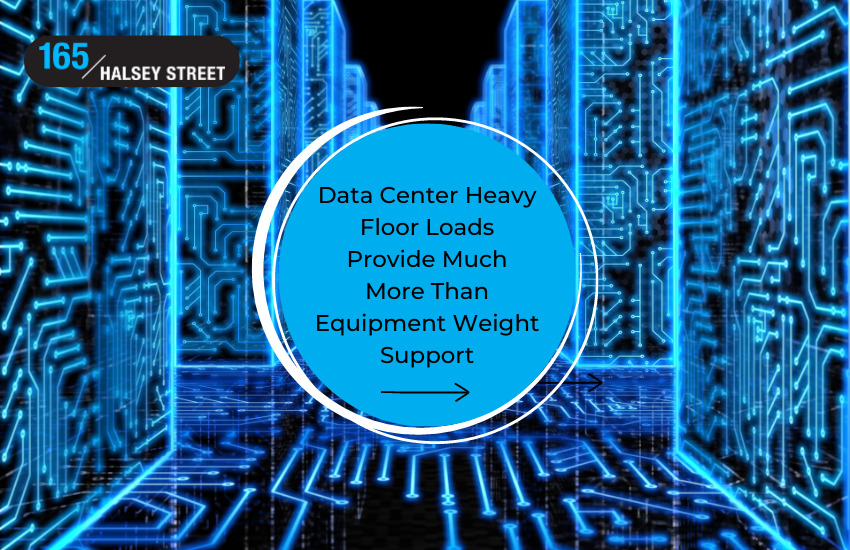Data center heavy floor loads are crucial when choosing a data center to support your servers and large equipment that keeps your operations running seamlessly. It’s important to realize, however, that the heavy floor load capacity supports so much more than weight, opening up other avenues within your data center floorplate layout to help with everything from future planning to cooling and cost efficiencies.
Data center floor loads refer to the amount of power or electrical load that a data center’s floor or designated space can support. It represents the maximum power capacity that can be allocated to IT equipment and other infrastructure within that specific area.
Floor loads are typically measured in terms of kilowatts (kW) or megawatts (MW) and are important considerations when planning and designing data center infrastructure. The electrical power requirements of servers, networking equipment, cooling systems, and other devices must be accounted for to ensure that the floor load capacity is not exceeded. Similarly, it helps determine the number and distribution of racks, power distribution units (PDUs), uninterruptible power supplies (UPS), and other components required to support the equipment.
In other words, by carefully managing floor loads and considering factors like power density and redundancy, data center operators can effectively balance power requirements and maintain reliable and efficient operations 24/7, 365 days a year. Find out more below by reading about the eight main heavy floor load advantages that support your data center operations!
1. Equipment Density Matters
Heavy floor loads allow for higher equipment density within the data center. By supporting heavier loads, data centers can accommodate more servers, storage systems, networking equipment and other hardware in a given space. This enables data centers to maximize their capacity and optimize resource utilization.
2. Sure-Footed Scalability
With heavy floor loads, data centers can easily scale up their infrastructure by adding more equipment and racks without compromising structural integrity. This scalability is crucial for accommodating the ever-increasing demand for computing resources and data storage capacity.
3. Future-Proofing is Important
By designing data centers with heavy floor loads, operators can ensure that their facilities can support evolving technologies and equipment with higher power and cooling requirements. Furthermore, this future-proofs the data center, reducing the need for significant infrastructure modifications or relocations when upgrading or expanding operations.
4. Provides Flexibility and Adaptability
Heavy floor loads offer greater flexibility and adaptability within the data center environment. Operators can reconfigure equipment layouts, make changes to the server racks, and optimize the use of space based on evolving business needs without being constrained by weight limitations.
5. Offers Enhanced Cooling Efficiency
Heavy floor loads can facilitate improved cooling efficiency within the data center. By densely packing equipment, it becomes easier to implement efficient airflow management and cooling systems, ensuring optimal temperatures for the equipment and reducing cooling costs.
6. Cost Optimization
Maximizing equipment density and scalability through heavy floor loads can also lead to cost optimization in data centers. Operators can achieve higher efficiency in terms of space utilization, power consumption, and cooling requirements. Therefore, this can result in reducing operational costs and better return on investment.
7. Reduced Footprint
With heavy floor loads, data centers can achieve more output with less physical footprint. As a result, the ability to accommodate larger equipment loads within a smaller area allows businesses to save on real estate costs, especially in urban environments where space is limited and expensive.
8. Improved Performance and Reliability
Data centers have power distribution systems, such as electrical panels and busways, to deliver power to the IT equipment on the data center floor. Floor loads help determine the overall power capacity of these distribution systems and ensure they do not overload, which could lead to electrical failures or downtime.
Choose 165 Halsey Street for Your Premier Data Center Needs
In brief, by supporting heavy floor loads, data centers can ensure stable and reliable operations. The robust infrastructure can handle the weight of equipment and minimize the risk of structural failures, which could otherwise lead to disruptions, downtime, and potential data loss.
165 Halsey Street has a heavy floor load capacity, capable of supporting the weight of large equipment and systems. As a result, this feature is particularly beneficial for companies that require specialized equipment, such as high-density servers or large storage arrays. Combined with a large floorplate with more than 1.2 million square feet, our spacious floorplate provides ample space for companies to house their IT infrastructure, servers, and equipment.
Above all, 165 Halsey Street offers a wide range of features and benefits that make it the premier data center facility in New Jersey. Discover why customers choose us and contact us today to learn more and see how we can meet your data center needs!
